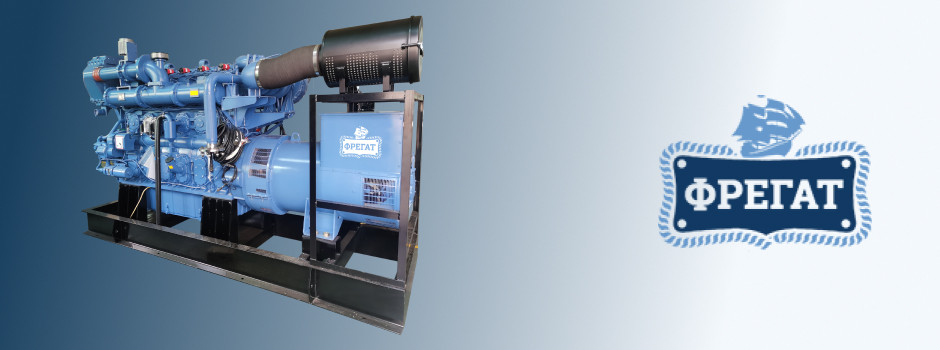Gas piston power plant device
The key element of the station is a gas piston internal combustion engine. In addition to it, an electric machine is installed on the frame, which converts mechanical energy into alternating electric current. To designate such a gas piston installation, the abbreviation GPU is used. A gas piston internal combustion engine is connected to it on one shaft.
When complete, the GPP is equipped with auxiliary systems that perform the following tasks:
- fuel is supplied;
- remove the smoke;
- they supply oil;
- ventilate the installation;
- provide communication;
- notify about emergency events;
- utilize thermal energy;
- extinguish fires;
- perform various functions of thermal mechanics and electromechanics.
The principle of operation of a gas piston power plant
The principle of operation of this equipment is similar to the principle of operation of the internal combustion engine. Fuel in the form of gas with the required characteristics is supplied to the engine. The generator and the gas piston engine are located on the same shaft. Mechanical energy is generated as a result of the fact that gas is burned and transformed into electricity energy.
The GPU engine is designed so that it provides an external system for producing a mixture of air and gas. Its task is to mix air and fuel in the aggregate state of the gas in the specified proportions. A gas mixing device with Venturi tubes is responsible for this.
The received energy of electricity is supplied to the distribution plant of the generator voltage. From there, electricity is distributed throughout the entire energy system of the facility. The energy goes to the next distribution plant.
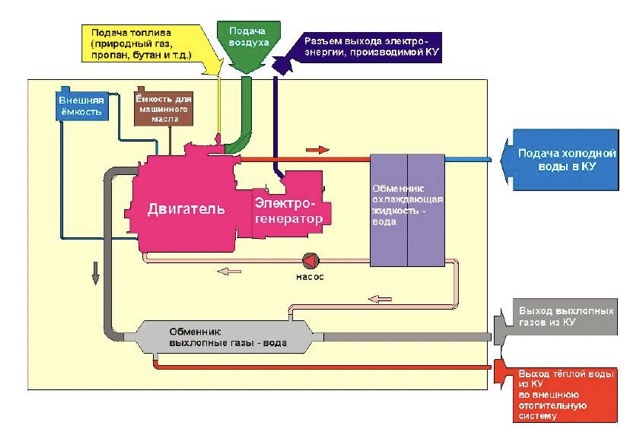
GPP operation mode
In relation to the external energy system, the station is capable of generating energy in two modes: parallel or autonomous. The choice of mode is determined by the specifics of the industrial facility. The parallel mode is characterized by increased reliability: electricity is supplied to the facility both from external networks and from the station. When operating offline, it is not necessary to connect to an external network. If there is a connection, it is allowed to temporarily disable it.
Attention! When switching to parallel mode, the GPP is synchronized with the reference values of the external network. For this reason, there is a possibility of a reverse flow of energy. Careful monitoring is necessary to avoid this risk. All owners of external networks put forward such a requirement by connecting mini-thermal power plants to their resources.
Fuel for gas-piston power plants
Gas piston engines are capable of operating on different types of combustible gases. It is important that the fuel is of high quality. As a rule, natural raw materials saturated with hydrocarbons are used. In addition, the stations are compatible with the following types of fuel:
- biogas;
- coking gas;
- mine gas;
- landfill gas fuel;
- methane from coal seams;
- petroleum gas fuel (associated or purification);
- propane or other gas in a liquid state.
As a substitute for natural fuel, it is acceptable to consider alternatives. Their composition and properties must be carefully studied in advance. It is allowed to use only those gases for the station that are compatible with the parameters recorded in the documentation from the manufacturer of the GPP.
Gas piston heat recovery system
During the operation of the GPP, it emits large amounts of heat. It is formed from:
- oil heated to high temperatures;
- cooling jacket of the internal combustion engine;
- exhaust gases.
Theoretically, heat can be released into the atmosphere, but this would be an unjustifiably irrational expenditure of valuable energy. In order not to lose, but to utilize this resource, boiler units and heat exchange devices are used. The saved energy is sent to industrial heating networks.
This approach allows you to obtain heat with the desired characteristics. For example, it can be hot water. Recycling boilers and heat exchangers are needed to obtain it. The standard temperature schedule for this process is 90/70°C. If necessary, heat the water even more, you will need to install peak boiler units.
When the heat is disposed of, saturated steam is formed. This requires special steam boilers. Superheaters are used to generate superheated steam.
Execution of gas piston power plants
Stations are not designed to be placed outdoors. They are installed on the territory of industrial facilities. The term "execution" refers to a specific method of arrangement and arrangement of equipment in an enterprise.
Gas piston stations are represented by two types:
- Stationary. They are installed in capital buildings.
- Block-modular. Both the installation itself and all systems for it are located inside a modular container. This small building is being built quickly and according to the same principle as the constructor.
The second option is optimal for sites that are small in size. It is in demand among customers who would like to save as much as possible and launch the station as soon as possible. Block models are ideal for multiple installation, disassembly and relocation to new places of work.
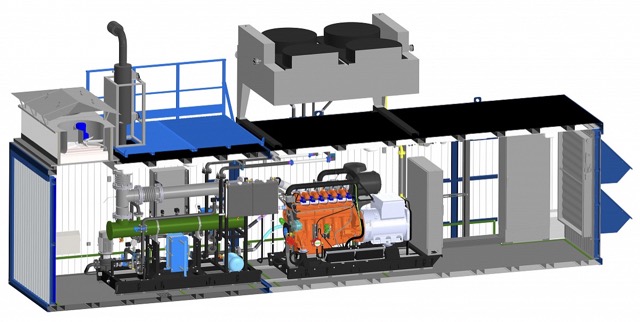
Advantages of block-modular stations
Block-modular structures are in consistently high demand for the following reasons:
- they can be put into operation very quickly;
- the modular approach to design significantly reduces the costs of customers;
- dismantling for the purpose of repair is carried out simply and promptly;
- the modular structure can be easily transferred to a new location and quickly assembled there, and conventional vehicles will be enough for this;
- when it becomes necessary to increase power, new modules can be connected to the station in the shortest possible time.
Efficiency of gas piston power plants
If the plant runs on gas, energy production is as cheap as possible. This is the optimal approach for industrial facilities that depend on a constant supply of energy. The cost of purchasing and/or generating fuel can be equal to half of the cost of generated heat and electricity.
Specific performance indicators are determined by the characteristics of the gas selected as a fuel. When calculating the profitability of a project, it is important to take into account four key aspects of gas:
- the degree of detonation;
- sulfur concentration (in percent);
- methane saturation;
- specific calorific value.
Gas piston installations are characterized by exceptional reliability and simplicity of design. Their efficiency is higher than that of other types of power plants: it can reach 45% when natural gas is used as fuel for energy generation.
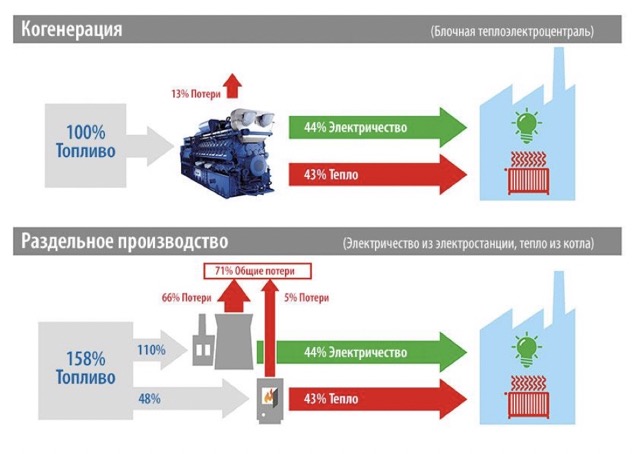
During the operation of the plant, trigeneration or cogeneration is achieved by heating the exhaust gases at the outlet to 400 ° C. For every 1 MW of electricity, 1 MW of additional thermal energy is produced. Efficiency increases by 100%.
Entrepreneurs who decide to establish their own GPP invest their finances with great benefit. Stations of this type are successfully used to supply electricity to the following types of facilities:
- industrial enterprises;
- gas boiler houses;
- various transport hubs;
- villages and towns;
- shift camps.
For the continuous operation of the plant, it is important to accurately calculate the volume of gas burned and optimize the supply of this fuel. The manufacturer is obliged to indicate the gas consumption in the documents for the station. Depending on the operating mode of the GPP, the installation can operate either continuously or at predetermined intervals.
Attention! To calculate the estimated gas consumption volumes, it is recommended to start from the level of 3-4 million cubic meters per year if the equipment operates without interruptions.
Pros and cons of GPU
The strengths and weaknesses of the GPU are almost the same as those of the internal combustion engine. This is not surprising, because the GPU engine is a special case of an internal combustion engine.
Gas piston installations are an autonomous alternative to supplying energy from the central grid. All elements of the station are systematically improved and refined. Generating electricity from a central source has long ceased to be the most profitable option — a mini-thermal power plant surpasses it in terms of economic efficiency.
GPU allows you to achieve the following goals:
- overcome dependence on central networks (the energy coming from there is not always of high quality, and its supply is often unstable);
- to guarantee the timely supply of electricity to the facility in the desired volumes;
- to increase the stability of the equipment, which depends on a constant supply of energy;
- solve the problem of energy supply to enterprises to which electric lines are too far away, and facilities that for some other reason cannot be connected to the city's power grids;
- reduce financial costs (due to the fact that no supply to communications is required, as well as connection to centralized heat and power supply networks); minimize monthly expenses (if you generate energy yourself, it will cost less than electricity purchased from grid companies).
The equipment is capable of operating in cogeneration and trigeneration modes, which is its significant advantage. Depending on the configuration, the installation can be operated in such a way that the associated heat energy will be usefully disposed of. Thus, the company will receive heat energy with lower costs than when purchasing from third-party suppliers.
There is only one argument against the construction of a mini-thermal power plant: a large amount of money will need to be invested in the project. However, the investment will pay off in the next few years.
Implementation of gas piston power plant projects
Specialized engineering organizations undertake the implementation of station projects. They offer customers a wide range of turnkey services, ranging from the development of an object project to its launch and debugging.
When implementing a project, it is critically important to adhere to a certain sequence of actions. It is unacceptable to skip individual steps or reverse the phases of the process. Any deviations from standardized procedures are fraught with malfunctions, loss of efficiency, increased risks of accidents and emergencies.
Ideally, the customer should fully entrust the implementation of the project to one contractor. Due to this, the cost of work will decrease. It will become easier for the selected company to carry out supervision and control throughout the work on the object.
Advantages of gas-piston power plants
In order to fully appreciate the advantages of a mini-thermal power plant, it is necessary to carry out a comprehensive construction of the station. Organizations that specialize in this type of construction usually create turnkey GPP for customers. The equipment comes from factories of reliable manufacturers.
Stations created to order by teams of experienced professionals have the following advantages:
- affordable price;
- compact dimensions;
- container version option;
- low cost of electricity generation;
- maximum efficiency in the range of 45-48%;
- generation of energy in the associated heat format with minimal costs, almost free of charge;
- extensive range of capacities;
- no need for frequent maintenance;
- long breaks between major repairs, without compromising the quality and safety of work;
- reasonable operating and maintenance costs;
- compliance with European safety criteria for humans and the environment;
- fast payback of the project.
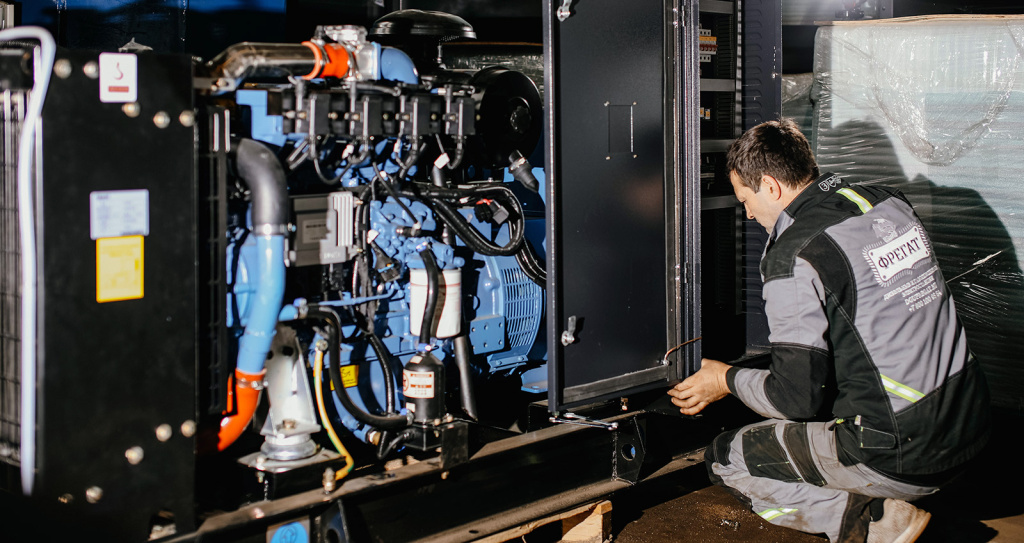
Economic feasibility of GPP
Before starting the construction of the station, it is necessary to calculate its productivity and profitability in advance. GPP contribute to reducing the cost of supplying facilities with energy. The closer the plant is located to the final energy consumer, the lower the costs. With the most rational planning, costs can be reduced to the cost of generated electricity.
The cost of gas-piston power plants
It is usually more profitable to produce electricity for own consumption than to purchase from network suppliers. It takes an average of 12 months to set up and launch one station. The payback horizon may vary according to the tariffs, but it is a maximum of 3 years. If you connect a resource-intensive enterprise to an external power supply network, the process can take 5 years or more. It will probably be necessary to create a special electrical line and build a substation.
When new customers turn to electricity suppliers to connect the company to the grid, the processing of applications is slow. The larger the customer, the higher the chances that the supplier will ask him to compensate for his expenses. The construction of its own GPP makes it possible to simplify, speed up and reduce the cost of obtaining access to energy.
Entrepreneurs are always interested in the upcoming amount of expenses. The estimated cost of the project can be calculated with great accuracy before starting its implementation.
When constructing a turnkey GPP, you should focus on costs in the region of €600-650 per 1 kW of power. These are very attractive prices. The benefits of a properly functioning plant significantly exceed the costs of installation and launch of the project.
The impact of gas-piston power plants on the environment
The operation of the station is not environmentally friendly. As a result of natural gas combustion, the equipment emits nitrogen oxides (NOx) into the atmosphere. Thanks to the installation of the MWM generator, the pollution level can be reduced to 500 mg/Nm3. When calculating the dispersion level, it is important to take into account the actual conditions at this particular moment. It is necessary to include a section of the GPP chimney in the calculations. This section should be 30 cm higher than the support of the building standing next to it.
The internal combustion engine of the GPU makes noise during operation. Additional noise load is created by ventilation devices.
In the case of a block station, the internal combustion engine is placed in a special container. Its ability to absorb outgoing sounds is at the level of 31-32 dBa, which is a decent indicator. This aspect becomes a priority if other buildings are located near the hydroelectric power station. Depending on the situation, it makes sense to use other methods and tools of noise protection, as well as to reduce other types of environmental impact of the station.
Attention! The noise volume and sound pressure are determined according to GOST 31295.2 standards.
Stages of construction of gas-piston power plants
Contractors engaged in the construction of such turnkey stations usually adhere to the following work scheme:
- They are developing a project. The contractor's team thinks over the main solutions of the object, coordinates its vision of the object with the customer and visualizes the object for him.
- The client agrees on the specification. A generator is supplied for the GPP.
- The team focuses directly on production. Specialists link the generator and other necessary systems. They create fences, supports and technical components that are not included in the main project.
- The station is being built and prepared for operation. They lay the foundation, build a building, install and assemble equipment (block or stationary). Communications are being laid, fences are being installed, access roads are being equipped, and the area surrounding the station is being improved.
- At the final stage, commissioning is carried out. The operation of the equipment is checked with and without load.
Organizations that are engaged in the construction of GPP usually offer additional remote services to customers. Their experienced teams are ready to monitor stations and act as dispatchers. This makes it possible to monitor the equipment in real time. This approach guarantees maximum reliability. If there are failures in the operation of the GPP, the dispatchers will respond to them immediately.
Only specialists who have received specialized training should serve the stations. The owners of the GPP entrust them to the staff of specialized organizations. With the official dealer of the generator manufacturer, you can sign a contract for the supply of spare parts at favorable prices and in an accelerated time.
Product catalog of TD Frigate on Enex

